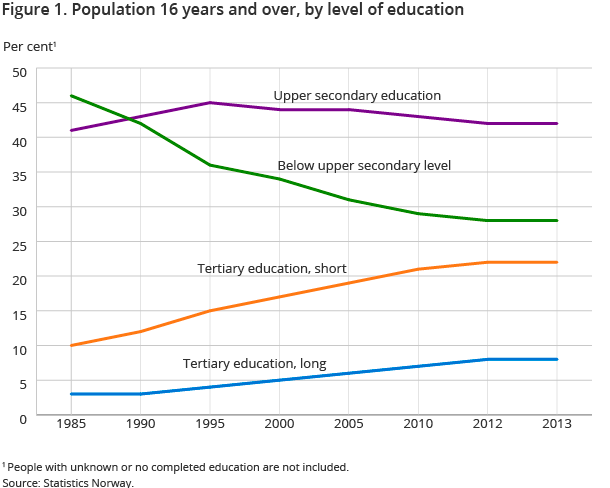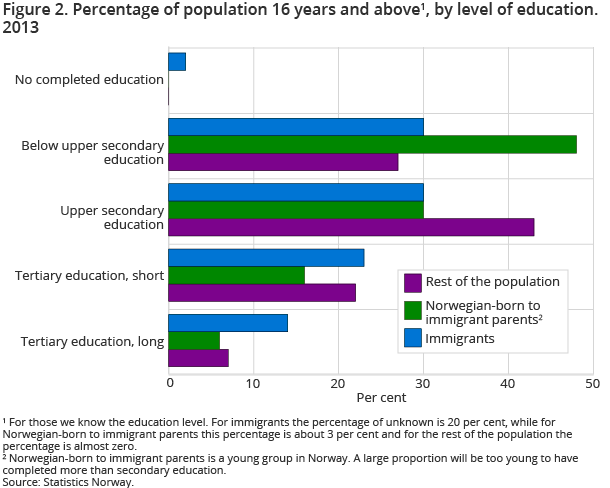Content
Published:
This is an archived release.
More women attain tertiary education
The share of women with a tertiary education has increased more than for men. In 1985, 15 per cent of men and 12 per cent of women have a tertiary education. In 2013, the situation is the opposite, and 33 per cent of women and 27 per cent of men have a tertiary education.
| 2008 | 2013 | |||
|---|---|---|---|---|
| Males | Females | Males | Females | |
| 1Includes intermediate level courses based on completed upper secondary level, but which are not accredited as tertiary education | ||||
| 2Tertiary education, short comprises higher education up to 4 years in duration. | ||||
| 3Tertiary education, long comprises higher education more than 4 years in duration. | ||||
| 4People with unknown or no completed education are not included. | ||||
| Total | 1 897 400 | 1 930 370 | 2 059 321 | 2 058 488 |
| Below upper secondary education | 539 025 | 577 710 | 547 342 | 555 896 |
| Upper secondary education1 | 835 940 | 761 551 | 879 332 | 771 151 |
| Tertiary education, short2 | 315 406 | 447 783 | 360 770 | 526 384 |
| Tertiary education, long3 | 148 691 | 93 487 | 179 403 | 137 267 |
| Unknown or no completed education | 58 338 | 49 839 | 92 474 | 67 790 |
| Shares4 | ||||
| Below upper secondary education | 29.3 | 30.7 | 27.8 | 27.9 |
| Upper secondary education1 | 45.5 | 40.5 | 44.7 | 38.7 |
| Tertiary education, short2 | 17.2 | 23.8 | 18.3 | 26.4 |
| Tertiary education, long3 | 8.1 | 5.0 | 9.1 | 6.9 |


The population’s level of education does not change much from year to year, but over a longer timeframe the changes have been substantial. In the period from 1985 to 2013, the increase in women with a tertiary education has been greater than the increase for men. For women, the share has increased by 21 percentage points, while for men the corresponding figure is 12 percentage points. The increase for women has particularly been seen in short tertiary education. As of 1 October 2013, one in four women have a short tertiary education, while in 1985, one out of ten women had a short tertiary education. The share for men with a tertiary education has increased from one out of ten to less than one out of five.
Larger proportion with tertiary education among younger age groups
Among the women aged 30-34 years, the share with a tertiary education is highest. Fifty-six per cent have a tertiary education and 27 per cent have an upper secondary education as their highest education level. Among men, the share with a tertiary education is highest for those aged 35-39 years, where 39 per cent have a tertiary education and 45 per cent have an upper secondary education as their highest education level. This fits well with the student statistics where we have seen an increase in the student figures at universities and college universities. The number of female students in particular has increased, and in recent years there have been more female than male students.
In this period, there have been major changes in the proportion with a lower secondary education as their highest education. In 1985, 46 per cent of the population had lower secondary as their highest education level, but this share decreased to 28 per cent in 2013.The share with upper secondary school as highest education level was stable. This share varied between 41 and 44 per cent of the population.
Every second person in Oslo has a tertiary education
In Oslo, nearly every second person aged 16 years or older attained a tertiary level of education. Oslo has the population with the highest education level among the Norwegian counties. Finnmark and Hedmark still have the greatest proportion with lower secondary school as the highest education level. In Finnmark, 37 per cent of those aged 16 years or older have below upper secondary as their highest education level, while in Hedmark and Nordland the share is 34 per cent. The counties Nordland and Nord-Trøndelag have the lowest share of people with a long tertiary education. In these counties, four per cent have a long tertiary education, while in Oslo 18 per cent have a long tertiary education.
Most people have attained a tertiary education in natural science, vocational and technical subjects
Thirty-two per cent of those who have attained a long tertiary education did so in natural science, vocational and technical subjects. Among men with a long tertiary education, 47 per cent attained a long tertiary education in the field of education. Most women, 23 per cent, attained a long tertiary education in the field of social science and law.
Unknown education excludedOpen and readClose
Persons with an unknown level of education are excluded when calculating proportions for the population’s level of education. Most of those with an unknown level of education are immigrants.
Contact
-
Andrine Stengrundet
E-mail: andrine.stengrundet@ssb.no
tel.: (+47) 95 48 60 28
-
Anne Marie Rustad Holseter
E-mail: anne.marie.rustad.holseter@ssb.no
tel.: (+47) 93 45 98 35
-
Maj-Lisa Lervåg
E-mail: maj-lisa.lervag@ssb.no
tel.: (+47) 45 68 84 72
